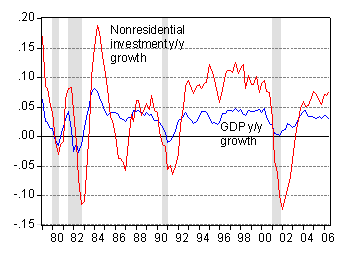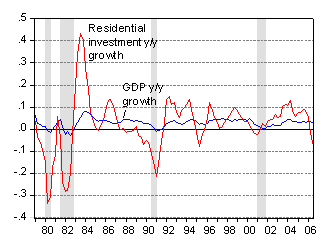One view of how GDP growth can be sustained in the wake of negative residential investment growth is to assert that business fixed investment picks up the slack. If this happens, then the adjustment of construction employment need not be too abrupt.
For instance, Dick Berner argued in yesterday’s Morgan Stanley Global Economic Forum article “All about Income”:
“In our view, higher operating rates, favorable financial conditions, and strong corporate cash flow will all support faster growth in business investment. While real US equipment and software spending slowed to just a 2.5% annual rate in the past two quarters, that deceleration seems to reflect one-time adjustments in fleet purchases of vehicles and in outlays for communications and photocopy equipment. Indeed, the 13.8% real increase in imported capital goods deliveries over the past two quarters speaks to vigorous demand.”
Similarly, in the Wall Street Journal article discussing the GDP report (“U.S. Economic Growth Slows Down,” sub. req.) is the following quote:
“David Huether, chief economist of the National Association of Manufacturers, said rising exports, business investment and consumer spending will cushion the economy from any further downturn in the housing market. “With three of the four pillars of the expansion remaining firm, the foundation for continued growth going forward is solid,” he said.”
The problem with this scenario is the following. As Robert Hall and David Papell’s textbook Macroeconomics states:
“Separating housing investment from business investment reveals some important timing differences. Both business investment and housing investment fluctuate widely during recessions and booms. But housing investment leads real GDP while business investment moves together with real GDP.” (page 298 of the 6th edition)
This assertion is supported by the following two figures.

Figure 1: Year on year growth rates (in log differences) of real GDP and nonresidential investment. NBER recession dates in gray. Source: BEA, 28 October NIPA release, and NBER.

Figure 2: Year on year growth rates (in log differences) of real GDP and resident investment. NBER recession dates in gray. Source: BEA, 28 October NIPA release, and NBER.
This suggests that if housing investment and the housing market do not rebound, and consumption is depressed by the reduction in housing wealth, then we’ll have to hope for rescue from the external sector. (Unfortunately, the external sector subtracted growth in 06q3; further see Stephen Roach’s critique of the decoupling hypothesis.)
Interestingly, Deutsche Bank (which accurately predicted 1.5% growth in ’06q3), despite being relatively bullish on a stabilization in the housing market, is forecasting 1 percent annualized growth in ’06q4.
Technorati Tags: recession, investment,
residential investment.
Professor, this graph helps illustrate Hall and Papell’s point too – it shows Residential Investment vs. Non-residential Investment. In general, RI leads Non-RI by 3 to 5 quarters.
Best Wishes!
Excellent graph, CalculatedRisk! Illustrative of a very regular temporal relationship between peaks & valleys. Speaks volumes.
Some of these mollifying sentiments like this:
have the tendency to provoke great calamity. Like the doctor telling you (for your own good!) that the slightlest anxiety could trigger your next and last heart attack.
So according to the more than mollifying Heuther, “rising exports, business investment and consumer spending will cushion the economy from any further downturn in the housing market”.
And we watch in fear as the rising exports continue to be outpaced by rising imports and the Wall-Mart projections are scaled back and business investment is problematic –some business leaders not being able to balance on that one remaining pillar prolly.
In 2004, according to the Census Bureau, there was $525 billion in new, private residential construction in the US.
By my count, there are 36 new nuclear reactors to be built between now and 2020 at about $3 billion each. That will require about $7 billion a year in investment if levelized. Add a couple uranium enrichment plants, some new US uranium mines, and maybe a fuel reprocessing plant over the same time period. The total new nuclear construction alone is then about 2% of current new residential investment.
Add increased investment in oil and natural gas extraction (ExxonMobil will surely plow some of its $10 billion annual profits back into the business), plus all those windmills and solar panels, new coal mines, etc and the energy sector can certainly pick up the slack, albeit not on a quarter-to-quarter time frame since residential is more volitile.
Look at the bright side – fewer new McMansions.
Calculated Risk: Thanks for the excellent graph. Sorry I missed you August post on the subject, but I think we’re on the same page now.
Joseph Somsel: Nukes? While NRC has received more than a couple dozen “expressions of interest”, there aren’t yet any plants approved for construction. Hence investment in those plants is not going to occur during the (business-cycle) time frame I have in mind, namely within the next year and a half.
Personally, I’d hope there’d be additional investment expenditures in cleaning up the Hanford (nuclear waste) Site before we start building new plants to generate more nuclear waste.
Professor,
You are misinformed. The NRC has a process called “limited work authorizations” and has publicly expressed the intention to focus its regulatory resources on those projects reading and willing to begin actual construction. I’m working on one such project and we are continually haranged by the owners to spend more money more quickly.
We turned our first dirt last week. Granted, it was core drilling for foundation investigations but big construction mobilization and hardware orders are not far behind. “Combined Operating Licenses” will take a while but need not be on the critical path.
Engineering work has already begun on several plants. Actual construction and fabrication orders for my project will start flowing into the global economy by 2nd quarter, 2007. While mine is only the lead project, many others are hot on our trail and competing for NRC review slots.
Clearly, the federal government’s priority is on making more nuclear capacity quickly. The REAL alternatives are coal, imported liquified natural gas, or blackouts.
If I were to make an off-the-cuff guess of aggregrate US cash flows, we’ll spend $1 billion in 2007, $3 billion in 2008, and $5 billion in 2009. Out-years will be limited by manpower and steel forging capacities.
You are probably right that in the next 6 or 8 quarters, residential volatility will predominant.
The Hanford site is a Cold War legacy and does indeed need cleanup. However, the nice thing about radioactive waste is that it disappears with time. Those vats are an urgent matter though.